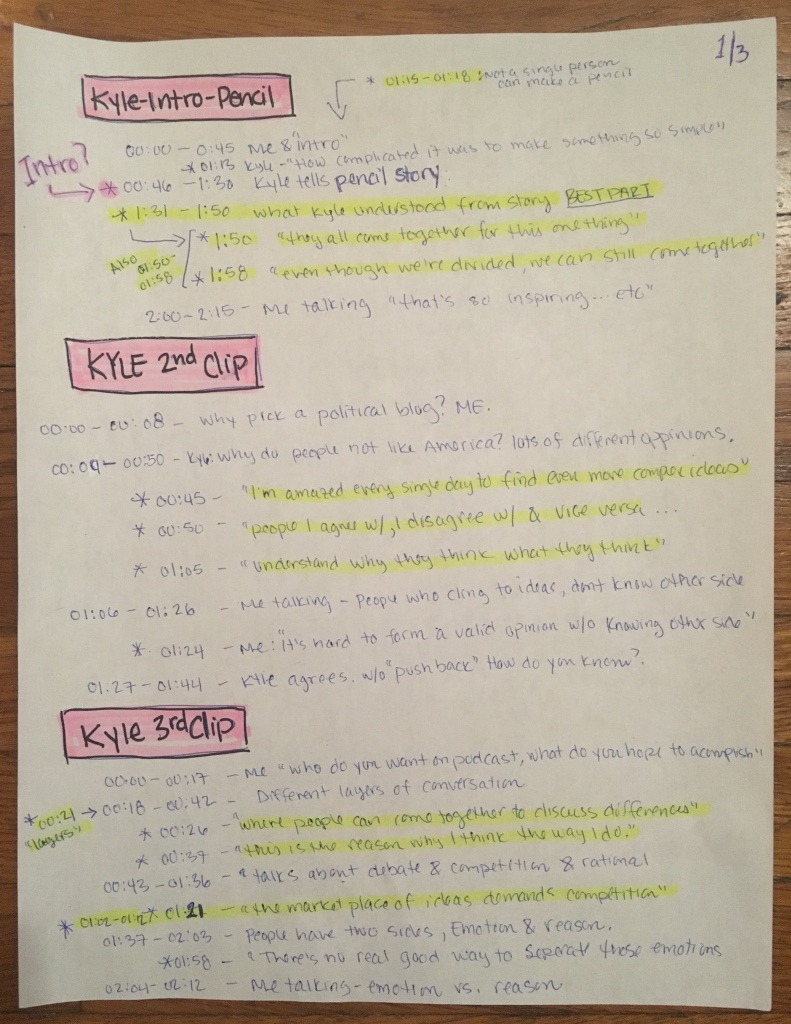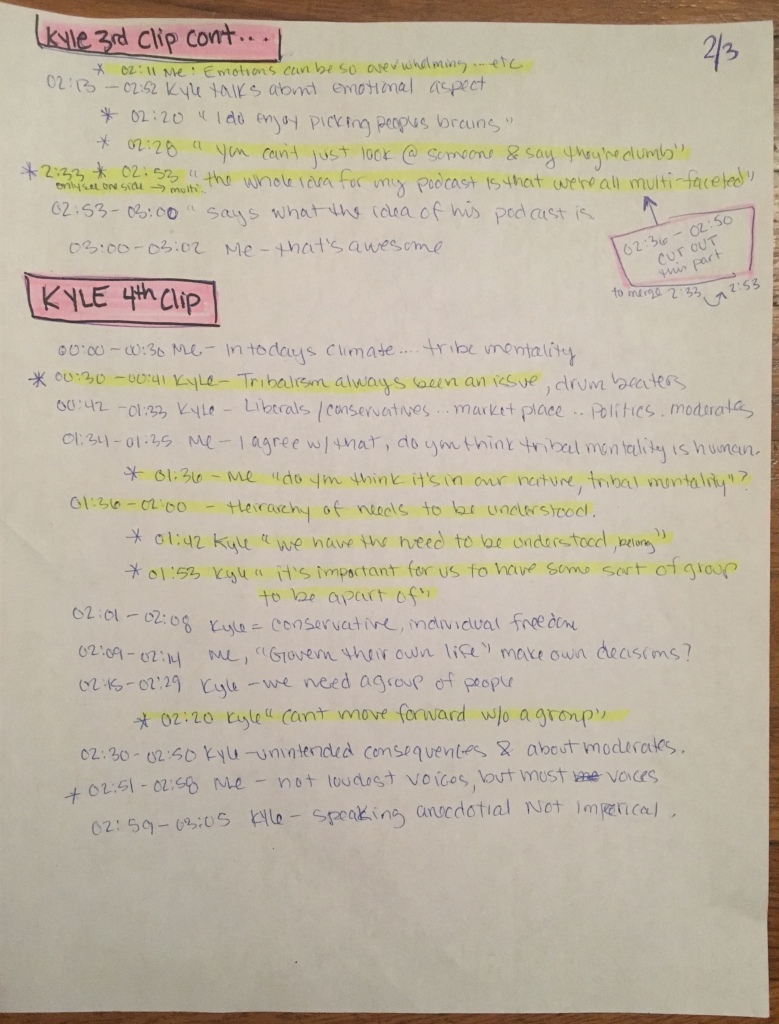I began the audio assignment for unit three by reflecting back on some of my favorite podcasts for inspiration; Radio Lab, The Joe Rogan Experience, This American Life and The Ricky Gervais Show. I tried to pin-point the characteristics and traits that I had enjoyed the most while listening to them, and assessed which aspects I could potentially utilize in my own audio project.
Since the objective of my course topic is to connect art and non-profit, I wanted to make sure that the interviewee I selected would have similar interests or at least be in a related field. But most importantly, someone who would want to be interviewed.
A good friend of mine, Kyle Rinta, had recently told me about a podcast that they were in the process of creating. The idea for the podcast had come from the current political climate in our county, and the growing divide between political parties. Kyle wanted to create a platform where people could respectfully discuss, face to face, their views and opinions. A safe environment to hear each other out, and possibly bridge the divide we seem to be facing in society.
Aside from it being a wonderfully optimistic idea for a podcast, it perfectly joined together the fields of art and non-profit in a way that could help people.
Prior to our informal interview, I wrote up a brief, but thoughtful list of questions and ideas that I wanted to cover in the audio recording. I didn’t want the interview to be scripted or stiff, but I didn’t want to accidentally leave out any key aspects.
To record the interview, I used the “Voice Memos” program on my laptop, and placed the computer in between the two of us to get an even audio recording.
I used the audio editing tip in this weeks readings and organized my content by “logging tape”. I created six individual audio clips ranging from 00:40 seconds to 03:06 minutes. For the first and last clip I recorded an interview introduction and story conclusion. The four middle audio segments referenced the general questions and ideas that I had previously established as well as the short story, “I, Pencil“, written by Leonard E. Reed that had inspired Kyle to create the podcast.
Once I had completed the interview and logged the tapes in chronological order, I sat down to listen through the recordings and transcribe them on to paper to visually organize their content. For each tape I wrote down a brief summary of the conversation with time-stamps referencing the key highlights, and best parts to potentially include in the draft story.
After establishing a visual reference for the interview with Kyle, I began the editing process.
To edit the audio clips, I launched Adobe Audition and imported each of the six clips to work on individually as new Multi-Track Sessions.
By utilizing the razor tool, I was able to select and delete specific time frames of each clip that contained un-wanted audio, such as, long pauses, redundancies, or awkward “ummms” in the conversation. In order to make sure the edited clips merged together seamlessly, I used the fade-in/ fade-out tool, as well as overlapping the ends of certain segments.
Once all six files were finished, I exported each session as a Multi-track Mixdown, saved them as MP3s, and then imported all of them into a new multi-track session.
Next, I cut, moved and placed the clips into the correct order, and listened to the final audio compilation to ensure everything was accurately placed.



Hi Valerie –
First, very impressive how you transcribed all your recordings to determine how you wanted to edit your project together. The visuals you included in your blog really give the reader a sense of the amount of work you put into this project.
I think even more impressive was that it took me a couple of times listening to your audio to realize you edited all that together! It truly sounded like one piece, so your use of the razor tool is fantastic!
I noticed the length of your audio went 26 seconds longer than the 3-minute length that was a firm requirement for our audio stories. So, with your amazing editing skills I’m sure you could find a way to shave off a bit of your story.
It’s a bit tougher to find a 2nd critique. It’s a podcast so I’m not sure if there’s room for music in the background somewhere? I don’t think music fits the ‘vibe’ that you are going for, but honestly, I struggled finding a 2nd way for you to improve this piece.
Nicely done!
Cyndi
LikeLiked by 1 person
Hi Cyndi,
Thank you for the compliment and feedback! I’ve been trying to figure out what parts to cut so I can get it down to only 3 minutes, such a tricky task! It seems like it’s almost harder to make a great SHORT audio story than a LONG one. You have to really “trim the fat” to find the best and most interesting parts.
In regards to your suggestion about background music or sounds, I’ve also been thinking about the same thing. I really enjoyed the way you layered ambient music into your audio story, and was tempted to also give it a shot. So thanks for the inspiration and feedback suggestions!
Best,
Valerie
LikeLike
Hi Valerie –
I wrote a reply earlier today and I have no idea where it went. So I’ll give it another try. I really enjoyed your audio story and particularly liked your topic. I also liked how you and Kyle talked about what inspired him to start this blog and what he helps to achieve — this helps to answer “why should I read/listen?” for anyone who isn’t sure. You picked a great interview subject because he does a good job of answering your questions in a way that’s easy to understand.
The two things you might consider doing differently are at the beginning and end. In the beginning, it would be interesting to learn a little about his background — has he written a blog before? Does he work in an environment that helps establish him as a good resource on this material? The other thing is in the conclusion is would be great to know how we can find this blog or learn more about it.
I’m envious of your topic — this political climate is something that is definitely topical. You did a great job and I look forward to hearing the finished product.
Take care
Mikal
LikeLiked by 1 person
Hi Mikal,
Great feedback suggestions! I hadn’t thought of either of those ideas, but they would certainly be great additions to the interview. I’m going to try it out and see how it flows.
Now I just have to figure out how to get the story down to only three minutes! Ahhh!
Thanks for the ideas and feedback!
Best,
Valerie
LikeLiked by 1 person
Hi Valerie,
I agree with Cyndi. I thought this was one continuous interview, so it was nice to see in your post the outline of where these conversation pieces actually occurred. It’s impressive that you took so many different pieces and were able to put them together in a way that felt like one continuous piece.
As for suggestions, the thing that stood out most to me was the background noise. If you can find a way to reduce it, then I think it would help your audience focus better on the content of the interview. I did find a video on how to use Audition to reduce background noise (https://www.youtube.com/watch?v=mcPMCAJyr08), but I haven’t tried it myself so I don’t know how easy or effective it is.
I’m struggling to come up with a second suggestion, because I think that you have is good and it flows really well together. I know that you’re a bit over the time limit, so maybe see if there are any segments that could be cut. I think your intro could be cut down a little bit because there are a few seconds that the beginning with umms and ahhs until it sounds like you get into a comfortable flow. I also think the clip where he mentions the specific pencil type (after “It’s called I Pencil”) could be cut, so it jumps to him saying “the story was…”. It might not be much, but I think it can save you a few seconds.
LikeLiked by 1 person
Thanks for the feedback, Kacee!
I totally agree with you about the background noise, I’ve been googling ways to eliminate it, so I’ll definitely check out that link you suggested! Thank you!
And good suggestion about cutting out the specific pencil type, I’ve been trying to figure out what segments to cut out so I can shorten the time. Great feedback!
Thanks again!
Valerie
LikeLike
I began this unit not really knowing what to expect. I’ve never worked with any audio editing software, and the Adobe Audition program was a little intimidating to me. However, after learning the basics through the tutorials, I was delightfully surprised to find myself genuinely enjoying the program. After recording and creating my draft interview, I was eager to listen to the audio stories of other group members, and read their feedback and suggestions.
I was inspired by the topics and draft stories that the rest of my group composed, and excited and grateful for their critiques and ideas regarding my story. Two specific areas of improvement that were mentioned were the background noise and audio length. I noticed a few videos posted in the “Advanced Audio Techniques” reading for week 10, so I’ll be checking those out to see if I can apply the techniques to my story. Kacee, a member of my group, also provided a YouTube link for me to watch on how to reduce background noise.
Aside from needing to shorten my draft down to 3:00 minutes, it was also suggested to me to possibly add some background information, in the beginning of the interview, about the individual in my story. It was a great suggestion, and I’ll definitely be trying it out to see how it could be incorporated into the introduction.
Overall, I’ve really enjoyed leaning how to use Adobe Audition. It’s a fun program with so many possibilities. I’m also incredibly grateful to have such great people in my peer feedback group. I value their ideas and opinions, and have learned a lot from all of them.
LikeLike